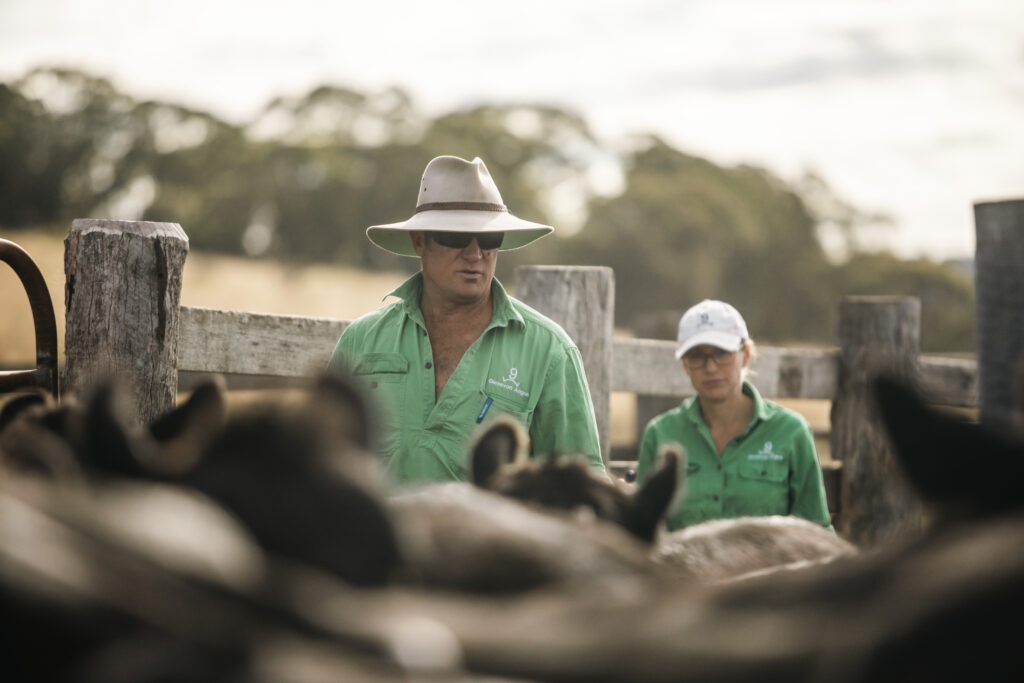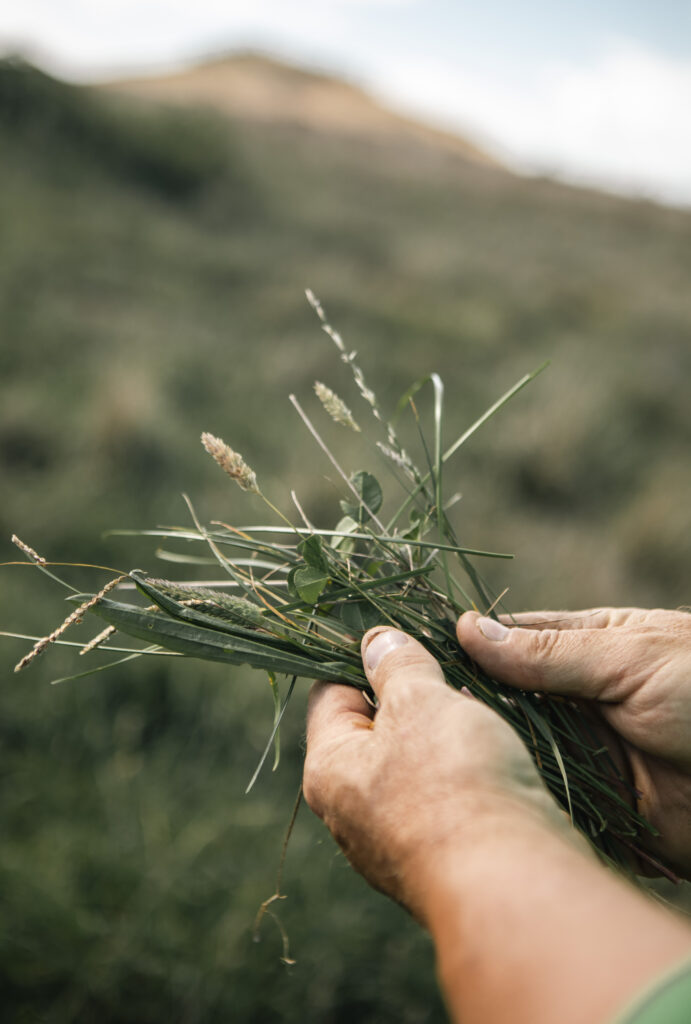Critical decision points when undertaking a soil carbon project

The decision to undertake a soil carbon project is significant – a business move not taken lightly by farmers Richard and Prue Post of Outer Bald Blair and Glenavon Angus stud. After years of research and analysis, they share the reasons behind why soil carbon farming made perfect sense for their family-run livestock enterprise.
Richard and Prue Post took over Prue’s family farm in 2016 – making Prue the fifth-generation to own and manage Outer Bald Blair – their main property which encompasses an Angus cattle stud, Glenavon Angus, outside Guyra, NSW. Their current business enterprises, equal in DSE (dry sheep equivalent), include an Angus seedstock herd, a commercial cow-calf operation selling progeny at feedlot weights and surplus heifers at their annual stud bull sale, and a prime lamb operation across 6,000 acres of mostly highly- improved basalt country in the New England region of NSW.
With a “fastidious approach” to performance across all aspects of their business and a strong reliance on data to guide their decisions, Richard says the couple was keen to understand whether carbon farming would fit with their overall program of improvements across Outer Bald Blair and their newly acquired nearby properties.
Key steps taken towards soil carbon farming
While Richard had been following the carbon movement in Australia since the Gillard Government’s reign, it took remerging from the 2019 drought to prompt a thorough, multi-year investigation into carbon farming as an opportunity for their business model.
Richard had been aware of carbon trading for quite some time given his background in financial markets, and hence paid attention when the Gillard Government was considering mandating a carbon price in Australia, he recalls, with the marketplace evolving in various ways since.
“The first step for us was to understand the present-day Australian carbon market and I became comfortable with that quite quickly,” he said.
“I then developed an understanding of the Clean Energy Regulator and how a [soil] carbon project worked. I realised carbon was something I wanted to know more about and to gain exposure to, from a business perspective.”
The real tipping point, Richard said, stemmed from insights gained through Precision Pastures’ Carbon Starter Report.

“The Carbon Starter Report was undoubtedly a critical decision-making tool for us to proceed with a project,” he said.
“We wanted to firm up our starting point on all farms given they were at different stages of development and production. With the help of Precision Pastures, we could confirm and quantify what the likely upside would be from the various management activities required in a soil carbon project and this process gave us the conviction to proceed.”
As part of this journey, Richard had been in contact with carbon project developers to assess which one would suit them best.
“We became increasingly comfortable with the Australian Soil Management business model and felt it was right for us. As our conviction grew that the risk-reward of a carbon project would be favourable for us, we were happy to pay upfront for the fees for the project but were adamant about keeping it registered in our name, and for us to keep any potential carbon credits we’d earn.
“I would never have signed up to a project that wasn’t in our name, which ruled a lot of developers out. That way, the project’s success – and risk – sits with us, and so do all the potential windfalls that come with it.
“Essentially, key things that started to line up more and more were that we were comfortable with the Australian carbon market and its integrity. Also, being a livestock enterprise with deep soil and high rainfall, we could see an opportunity to capture and monetise the potential upside in soil carbon that is likely to follow from our pasture improvements.”
The project
The Posts proceeded to register their project with the assistance of Australian Soil Management. The project is a total of 2,000ha (known as the ‘Project Area’). Eligible Activities (which form part of the Land Management changes required under the Australian Government’s soil carbon project methodology) include altering the stocking density and duration, otherwise known as switching from set stocking to more rotational grazing
“In reality, we were probably going to be doing a few of the Eligible Activities already because they made sense for our business, but we’ll effectively be moving to larger mobs and a higher stocking rate for more intense grazing and in turn, we’ll allow those paddocks to rest for a longer time in between movements,” Richard said.
Approximately 400ha of the entire project size comprises of new pasture which has been sown in recent years or will be sown in the next one-to-two years – a pasture “renovation” process the Posts had already planned to do as part of their focus on improving their adjacent land, lifting production and overall carrying capacity.

“We ended up taking 90-odd samples in our baseline which was greater than the threshold required but we opted to be more thorough in order to improve integrity above the minimum requirements set by the Clean Energy Regulator and to also to provide a lower level of variance from which we can verify our average soil carbon increase,” Richard said.
“The more samples we could take to possibly reduce the variation in our soils meant that there would be a lower withholding of future crediting – that was something we were happy to pay more for. These data we’ll obtain via soil testing will be a good tool for our improvements and a valuable tailwind for us.”
Overall, the Posts estimate the cost of undertaking a soil carbon project to be in the range of $300,000 over the 25-year permanence period, with the bulk of that attributed to the baseline and project establishment costs.
While Australian Carbon Credit Units may be earned in future years, the Posts have decided not to factor any financial gain into their budgeting process.
“We prefer to think of it as ‘optionality’. Earning credits is not something that we are financially forecasting, however we think we may review that after our first soil retest and see what progress we are making,” Richard said.
Advice to others – soil carbon not a ‘one size fits all’
To those considering a soil carbon project on their farm, Richard offers some insights acquired throughout his extensive research.
“First, find some people in your area that are already on this journey and speak with them, as this is a great starting point,” he said.
Secondly, Richard said that locking himself in a room to read the CER website about soil carbon projects was “surprisingly informative and straightforward, nor did it didn’t take me long to comprehend, as there are great fact sheets available”.
“Lastly, there is no doubt the Carbon Starter Report offered us the most insight that ultimately gave us conviction to proceed with a project. What we wanted from the report was to firm up our starting point of soil carbon levels across all our farms. Then, to quantify what the potential upside would be from the various activities you could undertake as part of a project.”

This report clearly defined the starting point by proceeding to Part B and having some samples taken on-farm. “The meeting we had with the Precision Pastures team to discuss our initial results, using their knowledge and intellectual property on what the likely increase in soil carbon and production would be from various eligible activities allowed us to answer major questions in detail – it was our ‘ah-ha’ moment.”
Richard acknowledges that the pastoral industry may not be unanimous on the benefits of carbon farming, however he believes it was a ‘right place, right time’ opportunity for their family business.
“A carbon project may not make sense for a lot of people or their operation, their environment or climate. This was a very unique opportunity for us because of our stage in life, the purchase of additional neighbouring country that needed work, and where we are located,” he said.
“Everyone’s circumstances are so different. There are plenty of good families and operators who have been improving their enterprises for years, so further gains on production are probably going to be small. While the Carbon Starter Report properly firmed up how high our soil carbon was at OBB – a highly improved, family-run farm – it showed us how to close the gap on the neighbouring properties which opened our eyes to how it could work for us.”
